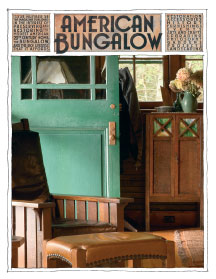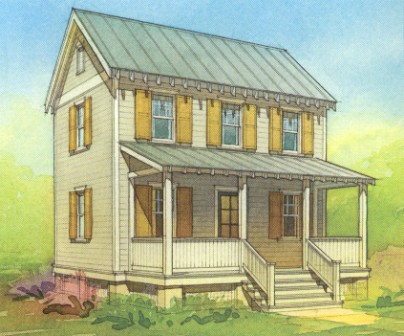 My favorite quarterly magazine is American Bungalow. It’s small, niche, and expensive, but it’s worth every penny for articles like the one in the summer 2008 edition titled “Brining Back Stinesville.”
My favorite quarterly magazine is American Bungalow. It’s small, niche, and expensive, but it’s worth every penny for articles like the one in the summer 2008 edition titled “Brining Back Stinesville.”
Nancy Hiller wrote this amazing piece on the town of Stinesville, IN and the preservation group Bloomington Restorations, Inc. In the 1990’s Stinesville’s population had dropped to around 200. The buildings were deteriorating, commerce was lacking. BRI is the patron saint of the dying small town, its chief goal to convert run down, abandoned and dilapidated buildings into affordable, historical housing. BRI came to Stinesville.
BRI isn’t a housing developer. They aren’t making millions on tract homes in cookie-cutter developments. They are revitalizing small towns using the existing community and in turn preserving the history built by past residents. What’s old – in some cases very, very old – is quite new again indeed.
I’m from a small town that gave into the need for housing by giving up hundreds of acres of land to developers. Where I once saw rolling green hills and long stretches of dirt road when I was a kid, I now find a Staples, a Wal-Mart and a thousand identical houses when I visit. It saddens me to no end that small towns across America suffer downsizing as residents flee to new shiny cities and developments, but I also understand the practicality of the decision.
BRI understands it too, and a fantastic excerpt from Hiller’s article explains their motivations:
“BRI completed its first Stinesville project with the restoration of the historic Hoadley House, which had been constructed near the end of the 19th century for the family whose limestone works had contributed so centrally to Stinesville’s one-time prosperity.

“Guided by a 1912 photograph, the BRI team created a diminutive three-bedroom house that today, with its artfully rebuilt front porch, positively shines in the morning sun.The last few lines of the article sum up the story of Stinesville perfectly, and give new hope to a hundred other dying towns across the US:
“BRI also managed the restoration of the town’s old doctor’s office. A tiny frame structure with kicked eaves and a cozy front porch that once functioned as a waiting room, the office was built in the 1890’s. After being restored and made habitable, the 450-square foot cottage was sold to a local social-service worker in 2006 for $45,000.”
“In a world where claims of “New!” and “Better!” are almost deafening, Stinesville’s quiet renewal after nearly a century of decline is proof that new isn’t always better. Sometimes, old can work.”
The article isn’t up online yet, but you can find the magazine in any Whole Foods or Borders. Check it out if you have a chance, and if you’re in the area, try to visit Stinesville.

Don Schenck
on 30 May 08Tiny Houses is my all-time favorite book about houses.
Sam
on 30 May 08American Bungalow is also my favorite. It helped sway my wife an I to buy a 94 year old bungalow instead of something newer. It was the right choice. The house is a joy to live in and has great character with all of the original oak. I love being in the dinning room with the built in buffet.
Jamie
on 30 May 08I honestly don’t know how people stay sane living in new McMansions. Craftsman homes bring such a sense of peace and harmony with the surroundings… Granted, they’re a limited commodity, since building codes and the cost of lumber prevent them from building them the way they used to.
For tiny homes, I’ve long been a fan of Tumbleweed Tiny Houses, but I was recently turned on to the awesomeness that is Tiny Texas Houses–awesome tiny homes making extensive use of reclaimed materials! Am I allowed to say “w00t” about salvage and homebuilding?
Jeff
on 30 May 08For those who like a little more elbow room (800-1500 sq ft), try The Not So Big House.
Bill
on 30 May 08I knew as soon as I saw BRI I knew that it had to have to connections to Bill and Gayle Cook. I benefited from some of their generosity to the community as a teenager and later worked for Bill’s company Cook Inc. They are wonderfully supportive of this kind of work and if you want to see what kind of preservation can be done on a large scale lookup the West Baden Hotel and the French Lick hotel. With the help of the Cooks $350+ million and a casino development 2 turn of the century historic hotels have been restored to their glory. If you want a little getaway they are worth checking out.
Tyler Karaszewski
on 30 May 08While that’s cool that they’re restoring old buildings, and I’ll agree that many of those older buildings have a lot more character than new tract housing, I wonder if they can really save the town of Stinesville with one house and one doctor’s office.
The town’s population has dropped to 200. Are there enough houses around to restore to bring the population back to 1,000? 10,000? 50,000? Even if so, how much would that cost, and would they be able to find people to live in them?
I guess I’m just not sure what the overall goal of this project is.
Terry Sutton
on 30 May 08Another example of why this is the best blog on the internet.
SH
on 30 May 08@Tyler Karaszewski, if you’ll read closely, you’ll see that census was taken 10 years ago. BRI has done extensive work in Stinesville, renovating and rebuilding A LOT of buildings, and the population has grown because of it. The two mentioned are just two, not all.
Geoff Graham
on 30 May 08While it sounds like BRI isn’t “making millions on tract homes in cookie-cutter developments,” they are definitely a “housing developer.”
A developer buys a property, has a vision for what it could be, turns it into that thing, and then either sells it or leases it to others to live, work, play or whatever. Requirements for the job include a tremendous amount of creativity, a great deal of business and marketing savvy, insight into the needs and wants of consumers, and a unnaturally high tolerance for risk and debt.
Historical work of developers include just about every piece of the built environment in existence. While there are a great deal of repulsive examples, many developers are trying to build stuff that’s worth a darn. Here’s one example relevant to this article (smaller spaces) and here’s another (enduring architecture, disclosure: I am involved in this project).
If you are interested in learning about innovative developers, some good resources include the Congress for the New Urbanism and the Urban Land Institute.
BRI is definitely up to something worth watching. Thanks for giving them some props.
Ricky Irvine
on 30 May 08Hot dog! This is fairly close to home, so I might try to venture up there.
David Andersen
on 31 May 08Geoff – thanks for the great links. I’On is beautiful. I had no idea something like this existed. Well done.
Platypus
on 01 Jun 08Watch Holmes on Homes (on the soon-to-be-former Discovery Home channel) for many examples of the new “craftsmanship.” I’ve seen enough bad examples to distrust any modern “developers.”
I’d rather have an old place.
iupress
on 06 Jun 08For those who are interested, Nancy Hiller will have a new book out with Indiana University Press in the Spring of 2009. It’s called The Hoosier Cabinet in Kitchen History, and it contains several black and white and color pictures. A good visual reference and inspiration for anyone planning period-inspired kitchens. Check back later for more details (only basic info is available now): http://www.iupress.indiana.edu/catalog/product_info.php?products_id=88561
This discussion is closed.